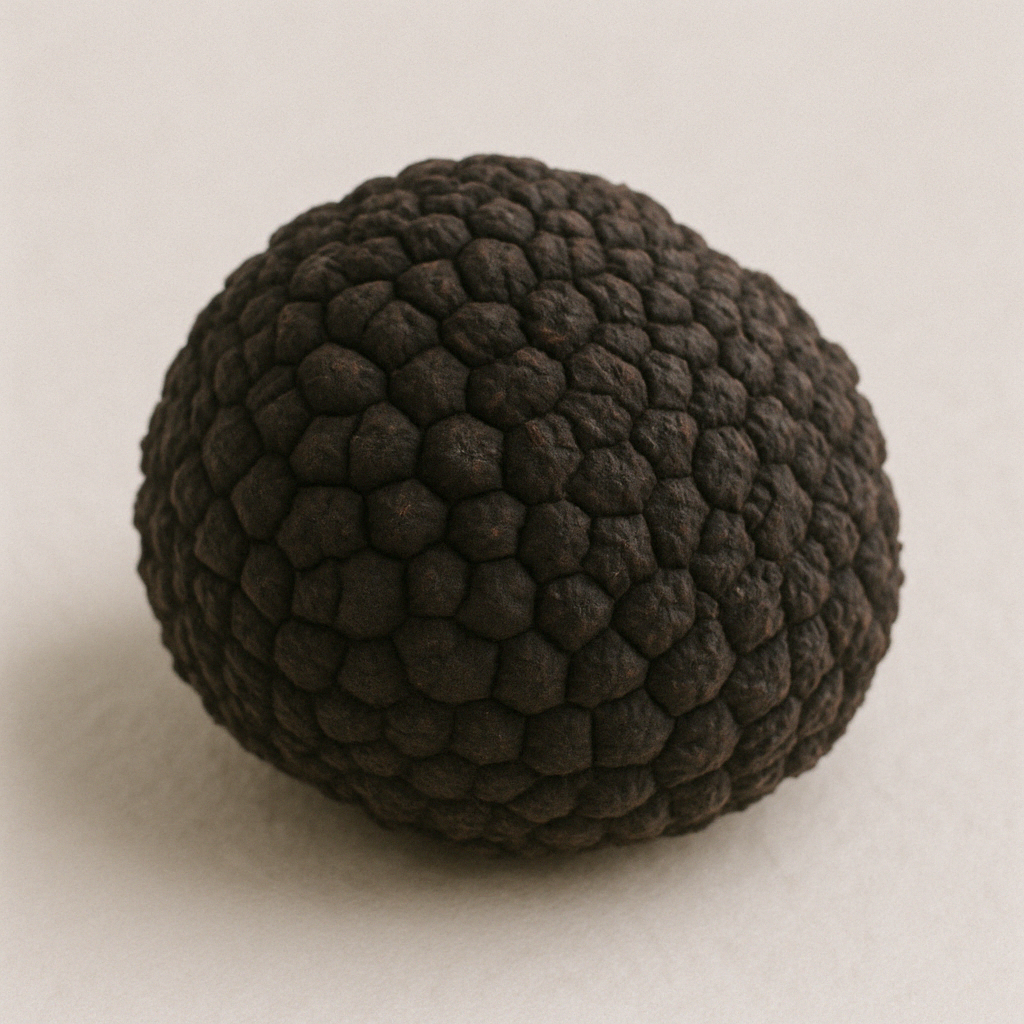
신선 트러플 from 이탈리아
Featured suppliers
/132x132/company-logo/dc/d9/8b/dcd98b43b84d929ce4407a97b9151f97ec6b97f5/logo_istituzionale_oro_.png)
/132x132/company-logo/ff/df/26/ffdf26168610799a837fdbb38d242d04800fc178/LOGO_VALNERINA__COLORE.png)
/132x132/company-logo/44/51/6d/44516d2801bbb3f80ccc9477e89cd9b42f23e653/Logo_senza_sfondo.png)
About this market
About
History
Truffles have been prized in Italy since Roman times, celebrated for their unique aroma and culinary value. During the Middle Ages, they were consumed by nobles and considered a delicacy throughout the Italian Peninsula. Today, Italy is internationally recognized for both wild and cultivated truffles. The country is best known for its three premier varieties: the Alba White Truffle (Tuber magnatum Pico), the Black Winter Truffle (Tuber melanosporum), and the Summer Truffle (Tuber aestivum). These truffles hold PDO and PGI recognition in some cases and are considered culinary treasures, widely used in haute cuisine and exported to major gourmet markets worldwide.
Production Regions
- Piedmont (Alba): Famous for white truffles (Tuber magnatum Pico); highly aromatic and rare.
- Umbria (Norcia, Spoleto): Known for black truffles (Tuber melanosporum and Tuber aestivum).
- Tuscany: Produces both white and summer black truffles; also used in truffle-infused products.
- Marche & Molise: Increasing production of Burgundy and summer truffles.
- Abruzzo & Emilia-Romagna: Traditional areas for both wild and cultivated black truffles.
Growing Conditions
- Altitude: 100–1,000 meters above sea level.
- Climate: Temperate with humid winters and warm summers.
- Soil: Calcareous, well-drained, and rich in organic matter.
- Habitat: Grows symbiotically with oak, hazelnut, poplar, and beech trees.
- Irrigation: Not required; truffles rely on natural soil moisture and climate.
Harvesting Process
- Foraging with Dogs: Specially trained dogs locate ripe truffles by scent.
- Manual Extraction: Harvesters gently dig around the truffle to avoid root damage.
- Seasonality: Dependent on variety—white truffles (Oct–Dec), black winter (Dec–Mar), summer truffles (May–Aug).
- Post-Harvest: Cleaned with soft brushes and stored at 2–4°C in breathable containers.
- Freshness: Shelf life is 5–10 days; immediate sale or processing is common.
Processing Methods
- Fresh Truffles: Sold whole to restaurants and gourmet distributors.
- Preserved Truffles: Sliced, pureed, or infused in oils, butter, or salt.
- Frozen: Used for off-season supply; less aromatic but longer shelf life.
- Infusions & Extracts: For sauces, condiments, and packaged foods.
Cultivation Methods
- Wild Foraging: Still dominant for high-end white and winter truffles.
- Truffle Orchards: Planted with inoculated trees, managed for 5–10 years before production.
- Certification: Mycorrhizae-certified trees are used in commercial truffle farming.
- Organic & Sustainable: Emphasis on biodiversity and non-chemical soil management.
Supply Chain
- Foragers & Farmers: Collect or harvest truffles in designated zones.
- Truffle Dealers: Aggregate from multiple sources for domestic and export sales.
- Exporters: Handle quality control, cold chain logistics, and documentation.
- Ports & Hubs: Milan, Turin, and Bologna are key trade and transport centers.
Local Logistics
- Cold Chain: Essential for preserving freshness during transit.
- Packaging: Vacuum-sealed or in breathable paper containers.
- Storage: Short-term refrigeration; longer-term requires freezing or preservation.
- Transport: Air and road freight; expedited shipping for fresh product.
Regulations and Certifications
- Regional Truffle Regulations: Govern foraging licenses, protected areas, and harvest quotas.
- PDO & PGI Status: Alba White Truffle (pending PDO); Norcia Black Truffle (PGI).
- Organic Certification: Recognized for orchard-grown black truffles.
- Food Safety: HACCP, EU food labeling, and phytosanitary rules for exports.
Quality Standards
- Grading: Based on size, aroma, firmness, and presence of surface damage.
- Moisture Content: Naturally varies by species and harvest time.
- Appearance: White truffles – irregular, pale beige with marbling; Black truffles – rough dark skin, white veining.
- Aroma Profile: Intense, earthy, musky for white truffle; nutty, garlicky for black truffle.
Trade Term
- HS Codes: 070959 (Fresh truffles), 071290 (Preserved).
- Exports (2023): ~80–100 MT of fresh and preserved truffles.
- Incoterms: Typically FOB (Italy), CIF for high-value air shipments.
- Payment Methods: Advance payment, wire transfer, or letter of credit.
- Minimum Order Quantity (MOQ): Typically 1–5 kg for fresh; smaller for processed.
Environmental Impact
- Positive Impacts: Supports forest biodiversity and rural land preservation.
- Challenges: Deforestation, climate change affecting fungal development.
- Conservation Initiatives: Sustainable foraging laws, tree-planting programs, and research on truffle ecosystems.
Social Impact
- Rural Livelihoods: Important seasonal income for small-scale foragers.
- Cultural Identity: Symbol of Italian gastronomy; featured in local festivals and cuisine.
- Community Co-ops: Enable fair trade and traceability.
Uses
- Gourmet Cuisine: Shaved over pasta, eggs, risotto, and meats.
- Truffle Oil & Butter: Flavor enhancers in fine dining.
- Preserved Truffle Products: Used in sauces, spreads, and gift boxes.
- Exports: High-value ingredient in premium food retail and HoReCa channels.
Additional Information
- National Uniqueness: Italy is one of few countries to supply all three major varieties
- Premium Pricing: Italian truffles often command the world's highest per-kilo price for gourmet food.
Harvesting seasonality
Varieties
White Truffle (Tuber magnatum Pico)
Most prized variety, intensely aromatic with a deep, earthy flavor. Grows naturally and cannot be cultivated.
Black Winter Truffle (Tuber melanosporum)
Also known as the Norcia or Périgord truffle. Dense aroma and nutty, garlicky notes. Can be cultivated.
Summer Truffle (Tuber aestivum)
Milder aroma than white or black truffles; widely available and more affordable. Used in sauces and preserves.
Export of 신선 트러플 from 이탈리아
Export overview
Export trend
Export transactions from 2024
Major exporters of 이탈리아 신선 트러플 in 2024





Major importers of 이탈리아 신선 트러플 in 2024





Historical export price trends
Verified suppliers
/132x132/company-logo/dc/d9/8b/dcd98b43b84d929ce4407a97b9151f97ec6b97f5/logo_istituzionale_oro_.png)
/132x132/company-logo/ff/df/26/ffdf26168610799a837fdbb38d242d04800fc178/LOGO_VALNERINA__COLORE.png)
/132x132/company-logo/44/51/6d/44516d2801bbb3f80ccc9477e89cd9b42f23e653/Logo_senza_sfondo.png)
/132x132/company-logo/94/9d/db/949ddb64b41e8151f0536226a4c194d1fec84eef/Stefania_Calugi_2024_Logo_OK_Nero.png)
/132x132/company-logo/c5/aa/49/c5aa498999d79459ff9566f87f0794821e595e14/logo-rustichella-nero.jpg)
/132x132/company-logo/8e/3a/6c/8e3a6cb60a3dda5c9ba3a7b18496cef3afd67726/LOGO-FT_1.jpg)
/132x132/company-logo/b8/fd/f9/b8fdf973902d05fd0ea23b1224a44ea240a9a011/truffleat-logo-C.jpg)
/132x132/company-logo/c6/10/cf/c610cfeedaadbaff8780ba023083247c00928eec/Nerobio.jpg)
/132x132/company-logo/0b/34/1c/0b341cc96e55b17191d6ce553a9d382e7f701292/Favorita-Live-solo-logo_oro_verticale.png)

/132x132/company-logo/cc/04/b2/cc04b2d00fce1fd48c4e7b7addaa189ddf7adee4/Cattura_del_logo.PNG)

